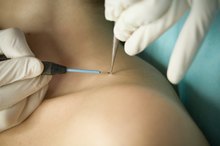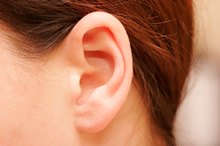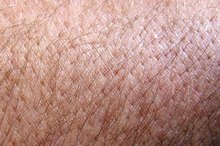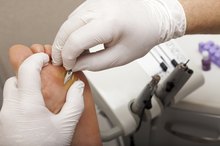What Are Over-the-Counter Treatments for Molluscum Contagiosum?
Molluscum Contagiosum is sometimes mistaken as a wart 13. Although both are caused from viral infections, Molluscum Contagiosum is caused by a pox virus, while warts are caused by the human papilloma virus 13. The wart-like lesions that are caused from Molluscum Contagiosum usually go away on their own 13. Depending on the area of the outbreak, over the counter treatment may be sought for cosmetic or discomfort reasons. Treatment is usually sought to avoid contamination.
Acne Medication
Tretinoin, which is found in Retin-A and is used as an acne medication, can also be used on Molluscum Contagiosum 13. Tretinion can be found in over the counter products in the form of vitamin A in many facial products that promote cell renewal and wrinkle reducing creams and lotions. The cream is rubbed on the affected area daily. Depending upon the breakout, this form of treatment may take from several weeks to several months before improvement is seen.
- Tretinoin, which is found in Retin-A and is used as an acne medication, can also be used on Molluscum Contagiosum 1.
- Tretinion can be found in over the counter products in the form of vitamin A in many facial products that promote cell renewal and wrinkle reducing creams and lotions.
Salicylic Acid
How to Remove a Filiform Wart
Learn More
Salicylic acid, such as that found in Compound W, which is a commonly known aid in removing warts, can also be beneficial in removing the lesions caused from Molluscum Contagiosum 13. The application directions of the salicylic acid should be followed in the same manner as if treating a wart. This form of treatment kills the wart-like bump in layers, and may take several weeks. This form of treatment also requires that you remove the top layers of the lesions as they are killed.
- Salicylic acid, such as that found in Compound W, which is a commonly known aid in removing warts, can also be beneficial in removing the lesions caused from Molluscum Contagiosum 1.
Freezing
There are over the counter treatments for Molluscum Contagiosum that will freeze the affected area, and cause the papule to fall off once treatment is complete 13. Several companies, such as Dr. Scholl, offer a product that is advertised to freeze warts. These products are based on the same concept as the liquid nitrogen that is used by physicians in the removal of warts.
Wart Removers
How to Remove Facial Milia
Learn More
Most over the counter wart removers will work on Molluscum Contagiosum in the same way they work on warts 123. These products are found in liquid form that are applied daily, that require continual attention for application and dead skin removal. Products are also available as medicated pads and bandages, that are worn for one day to one week before changing. This form of treatment requires minimal care, with attention only to proper time of changing the pad or bandage.
- Most over the counter wart removers will work on Molluscum Contagiosum in the same way they work on warts 1.
- Products are also available as medicated pads and bandages, that are worn for one day to one week before changing.
Prevent Spreading the Virus
Molluscum Contagiosum is a viral eruption on the skin 13. This form of virus is contagious through contact when the lesion is present. An outbreak usually last for six to nine months. With no medical interference, after the viral eruption has run its course, Molluscum Contagiosum will go away with no scarring 13. But, because they are contagious through contact, destruction of the lesion is advised to reduce the risk of spreading the virus to other parts of the body, and reduce the risk of spreading to others.
Consult your physician for proper diagnosis before administering any over the counter products or drugs.
- Molluscum Contagiosum is a viral eruption on the skin 1.
- But, because they are contagious through contact, destruction of the lesion is advised to reduce the risk of spreading the virus to other parts of the body, and reduce the risk of spreading to others.
Related Articles
References
- Molluscum Contagiosum, a pox virus
- Wart removers
- Organic treatment of Molluscum Contagiosum
- Silverberg NB. Pediatric Molluscum Contagiosum. Pediatric Drugs. 2003;5(8):505-512. doi:10.2165/00148581-200305080-00001
- Tyring SK. Molluscum contagiosum: the importance of early diagnosis and treatment. American Journal of Obstetrics and Gynecology. 2003;189(3). doi:10.1067/s0002-9378(03)00793-2
Writer Bio
Vonnie Chestnut, from Dover Oklahoma, has been writing for over 10 years. She worked in special services, for 14 years, which enhanced her ability to write web-based, informative, medical and educational content. She is published in "Jones Mechanical Turk", anthologies, newspapers in Oklahoma, as well as several article based websites.









